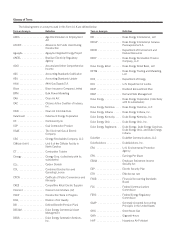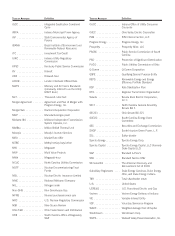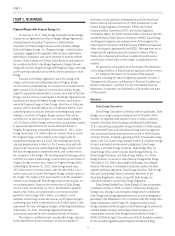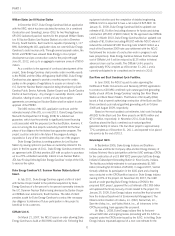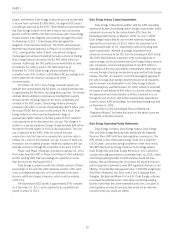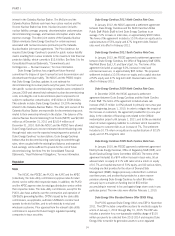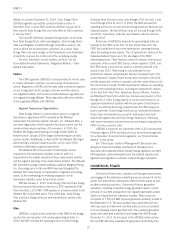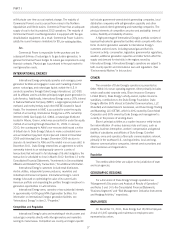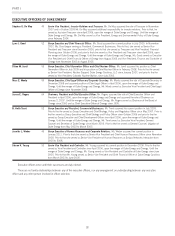Duke Energy 2011 Annual Report Download - page 30
Download and view the complete annual report
Please find page 30 of the 2011 Duke Energy annual report below. You can navigate through the pages in the report by either clicking on the pages listed below, or by using the keyword search tool below to find specific information within the annual report.
PART I
project, and therefore Duke Energy Indiana should only be permitted
to recover from customers $1.985 billion, the original IGCC project
cost estimate approved by the IURC. Other intervenors recommended
that Duke Energy Indiana not be able to rely on any cost recovery
granted under the CPCN or the first cost increase order. Duke Energy
Indiana believes it has diligently and prudently managed the project.
On September 9, 2011, Duke Energy defended against the
allegations in its responsive testimony. The OUCC and intervenors
filed their final rebuttal testimony in Phase II on or before October 7,
2011, making similar claims of fraud, concealment and gross
mismanagement and recommending the same outcome of limiting
Duke Energy Indiana’s recovery to the $1.985 billion initial cost
estimate. Additionally, the CAC parties recommended that recovery
belimitedtothecostsincurredontheIGCCprojectasof
November 30, 2009 (Duke Energy Indiana estimates it had
committed costs of $1.6 billion), with further IURC proceedings to be
held to determine the financial consequences of this
recommendation.
On October 19, 2011, Duke Energy revised its project cost
estimate from approximately $2.82 billion, excluding financing costs,
to approximately $2.98 billion, excluding financing costs. The revised
estimate reflects additional cost pressures resulting from quantity
increase and the resulting impact on the scope, productivity and
schedule of the IGCC project. Duke Energy Indiana previously
proposed to the IURC a cost cap of approximately $2.72 billion, plus
the actual AFUDC that accrues on that amount. As a result, Duke
Energy Indiana recorded a pre-tax impairment charge of
approximately $222 million in the third quarter of 2011 related to
costsexpectedtobeincurredabovethecostcap.Thischargeisin
addition to a pre-tax impairment charge of approximately $44 million
recorded in the third quarter of 2010 as discussed above. The cost
cap, if approved by the IURC, limits the amount of project
construction costs that may be incorporated into customer rates in
Indiana. As a result of the proposed cost cap, recovery of these cost
increases is not considered probable. Additional updates to the cost
estimate could occur through the completion of the plant in 2012.
Phase I and Phase II hearings concluded on January 24, 2012.
Final orders from the IURC on Phase I and Phase II of the subdocket
and the pending IGCC Rider proceedings are expected no sooner
than the end of the third quarter 2012.
Duke Energy is unable to predict the ultimate outcome of these
proceedings. In the event the IURC disallows a portion of the plant
costs, including financing costs, or if cost estimates for the plant
increase, additional charges to expense, which could be material,
could occur.
The Edwardsport IGCC facility is approximately 97% complete
as of December 31, 2011 and is expected to be completed and
placed in service in 2012.
Duke Energy Indiana Carbon Sequestration.
Duke Energy Indiana filed a petition with the IURC requesting
approval of its plans for studying carbon storage, sequestration and/or
enhanced oil recovery for the carbon dioxide (CO2)fromthe
Edwardsport IGCC facility on March 6, 2009. On July 7, 2009,
Duke Energy Indiana filed its case-in-chief testimony requesting
approval for cost recovery of a $121 million site assessment and
characterization plan for CO2sequestration options including deep
saline sequestration, depleted oil and gas sequestration and
enhanced oil recovery for the CO2from the Edwardsport IGCC facility.
The OUCC filed testimony supportive of the continuing study of
carbon storage, but recommended that Duke Energy Indiana break its
plan into phases, recommending approval of only $33 million in
expenditures at this time and deferral of expenditures rather than cost
recovery through a tracking mechanism as proposed by Duke Energy
Indiana. The CAC, an intervenor, recommended against approval of
the carbon storage plan stating customers should not be required to
pay for research and development costs. Duke Energy Indiana’s
rebuttal testimony was filed October 30, 2009, wherein it amended
its request to seek deferral of $42 million to cover the carbon storage
site assessment and characterization activities scheduled to occur
through the end of 2010, with further required study expenditures
subject to future IURC proceedings. An evidentiary hearing was held
on November 9, 2009.
See Note 4 to the Consolidated Financial Statements,
“Regulatory Matters,” for further discussion on the above in-process
or potential construction projects.
Duke Energy Generating Facility Retirements.
Duke Energy Carolinas, Duke Energy Indiana, Duke Energy
Ohio and Duke Energy Kentucky each periodically file Integrated
Resource Plans (IRP) with their state regulatory commissions. The
IRPs provide a view of forecasted energy needs over a long term
(15-20 years), and options being considered to meet those needs.
The IRP’s filed by Duke Energy Carolinas, Duke Energy Indiana,
Duke Energy Ohio and Duke Energy Kentucky in 2011 and 2010
included planning assumptions to potentially retire, by 2015, certain
coal-fired generating facilities in North Carolina, South Carolina,
Indiana, Ohio and Kentucky that do not have the requisite emission
control equipment, primarily to meet EPA regulations that are not yet
effective. These facilities total approximately 3,300 MW at eight sites
(Dan River, Riverbend, Lee, Buck units 5 and 6, Wabash River,
Gallagher, Beckjord and Miami Fort unit 6). Duke Energy continues
to evaluate the potential need to retire these coal-fired generating
facilities earlier than the current estimated useful lives, and plans to
seek regulatory recovery for amounts that would not be otherwise
recovered when any assets are retired.
10





